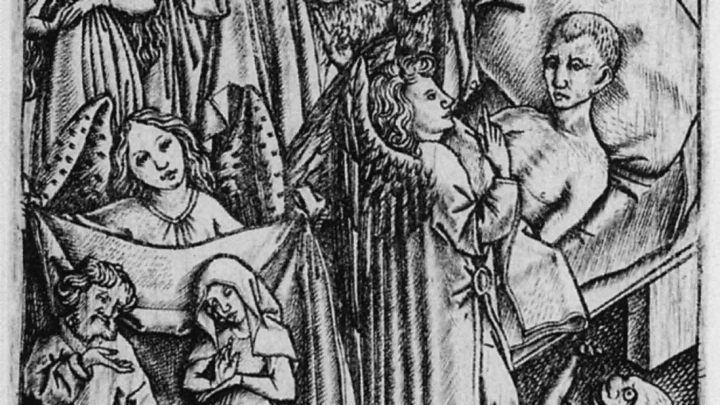From dying to being a king, these manuals had people in the Middle Ages covered.
1. How to Die Well
The Middle Ages was a good time to learn how to die. If you avoided the Black Plague and survived the 100 Years War, you still might get some of your disease-laden drinking water on a hangnail and die of septicemia. It was during this time that an instructional pamphlet, Ars Moriendi: The Craft of Dying (top photo), started making its rounds among the population of Europe. Appearing sometime in the early 1400s, the Ars Moriendi was a small book of six chapters, each one written to help a dying soul and those attending him to ease the passage into death. As the book grew in popularity and became widely translated, a second, shorter version, which had more pictures and less writing, became available.
The book was written with the idea that in a man’s desperate last hours, he becomes a target for Satan like never before. Ars Moriendi teaches how to withstand that battle. As the first chapter says, death need not be feared. In fact, the book gives a “commendation of Death, and the cunning to die well.” Other chapters help a person avoid despair in their final hours, pose questions to be asked of him to make sure his eternal soul is in order, and offer comforting prayers to say by his bedside.
2. How to Battle
Gunpowder slowly began having a say in European warfare between the 14th and 16th centuries. Before that, combat (and there was a lot of combat) was sword to sword.
Well, that’s not exactly true. There were swords, both long and short, spears, maces, pole-axes, daggers, messers, bucklers, bows, crossbows, and lances. Not to mention the art of using any of the above while on horseback, wrestling, fighting two against one, shield use, and how (Plate 242) to fight a woman (the man must stand in a pit with a wooden mace, the woman above him with a 5 pound stone tied into her veil. Presumably these instructions were for judicial battles or other organized fighting.) If this seems like a lot to learn, it was. The scribes of the time produced many manuals, largely pictorial, to help soldiers learn their craft. The woodcuts above are from a popular series of books written by Hans Talhoffer.
3. How to Punish Sins
Having your priest give you a private penance for your sins was a new idea in the early Middle Ages. Before then, people confessed their sins publicly, and maybe only once in their lifetime. In the 6th century, Irish monks begin making extremely detailed lists of possible sins, called Penitentials, along with the punishments to pay for committing them. Some of the punishments (fasting for 4 years for fornication with a virgin) are likely the result of muddled translation or a variable definition of “fasting.” Other sins and precise punishments from the Penitential pamphlet Corpus 190 of the Canons of Theodore include:
-He who desires to fornicate (with) himself (i.e., to masturbate) and is not able to do so, he must fast for 40 days or 20 days. -If he is a boy and does it often, either he is to fast 20 days or one is to whip him. -Whoever fornicates with another man's wife must fast for 4 years, 2 wandering in grief, 2 (years) more (fasting) during the 40-day periods and 3 days each week. -Whoever fornicates with an effeminate male or with another man or with an animal must fast for 10 years
4. How to Care for the Sick
The Fasciculus Medicinae was the first illustrated medical manual to be put into print, in the late 1400s. Actually, it wasn’t so much a manual as a bound collection of separate works about medicine and anatomy. The anatomy was, shall we say, very interpretive in some cases, such as The Zodiac Man. Or in the case of The Incised Man, rather scary, giving detailed directions for where it was best to cut and bleed patients for whatever particular ailment they suffered (“Incisions in the two veins behind the ears, on both sides, are useful for improving memory and cleansing the face of pustules, and against all other spots on the face”). The book widely added to medical knowledge, for good or ill, in the Middle Ages, and the woodblock illustrations influenced the art of the period.
5. How to be a King
Only a small fraction of the population of Medieval Europe read or wrote. Because of this, most books either concerned the church, the wealthy, or the nobility. Often all three of these attributes would be found in the same person. One of the most popular genres of “advice books” during this time was called “Mirrors for Princes.” They were often written by noble relatives, respected scholars, or religious leaders to be presented to new nobility as they came to power. These books were meant to instruct young royalty of their duties and their history. Most of these books, alongside records of battles and studies of other monarchies, instruct on the need for piety, benevolence, and the important of a praiseworthy life. A famous exception is the book The Prince by Niccolò Machiavelli. Machiavelli taught that it was better to be feared than loved, better to be stingy than generous (so as not to encourage greed in your subjects), and how to avoid contempt and hatred while adhering to the rest of his suggestions. Unlike most Mirrors, Machiavelli’s book is still widely read today.
